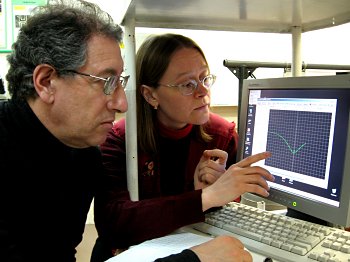Superconductors, materials with zero electrical resistance, have been known for decades, but their counterpoint materials, the superinsulators, could transform materials research and electronics design. Now, an international team of scientists has created a material that at close to absolute zero has an electrical resistance 100,000 times higher than its room temperature value.
Valerii Vinokur of Argonne National Laboratory and colleague Tatyana Baturina working with others at Argonne, in Belgium, Germany, and Russia, have prepared a very thin film of titanium nitride with a view to finding a superinsulator. As with superconductors, which have many applications in particle accelerators, spectrometers, MRI machines, and magnetic-levitation trains, the unique properties of superinsulators could be used to improve all kinds of electrical and electronic circuits, sensors and battery shields to prevent premature discharge or short circuits.
 “Titanium nitride films, as well as films prepared from various other materials, can act as either superconductors or insulators depending on the thickness of the film,” explains Vinokur. “If you take the film which is just on the insulating side of the transition and decrease the temperature or magnetic field, then the film all of a sudden becomes a superinsulator.”
“Titanium nitride films, as well as films prepared from various other materials, can act as either superconductors or insulators depending on the thickness of the film,” explains Vinokur. “If you take the film which is just on the insulating side of the transition and decrease the temperature or magnetic field, then the film all of a sudden becomes a superinsulator.”
Vinokur points out that a superinsulator material could be used to encapsulate a superconducting wire. Such a coupling would create an almost perfect wire in which virtually no energy is lost as heat. A miniature version of such superinsulated superconducting wires could one day lead to the most efficient electrical circuits possible.
 Titanium nitride becomes a superconductor because its electrons form Cooper pairs, which can join to form long chains that allow unrestricted motion of electrons and so reduce the resistance to a current flow to zero. Split the Cooper pairs, however, a phenomenon that occurs below the transition, and the superconductor becomes a superinsulator as suddenly there is a huge electrical force opposing the current flow.
Titanium nitride becomes a superconductor because its electrons form Cooper pairs, which can join to form long chains that allow unrestricted motion of electrons and so reduce the resistance to a current flow to zero. Split the Cooper pairs, however, a phenomenon that occurs below the transition, and the superconductor becomes a superinsulator as suddenly there is a huge electrical force opposing the current flow.
http://dx.doi.org/10.1038/nature06837
Nature, 452, 613-615, 2008
Comments are closed.